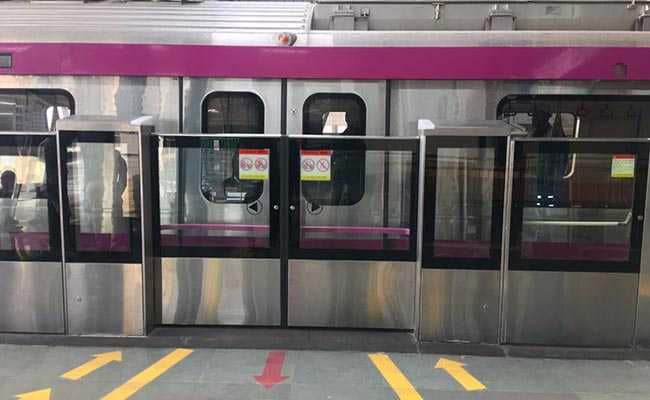
The platform screen doors open only when a train arrives and shut after it departs.
New Delhi:
The upcoming Magenta Line of the Delhi Metro that will bring Noida closer to south Delhi, in many firsts, will have platform screen doors (PSDs) and a high-tech signalling technology for movement of trains, officials today said. The 12.64-km stretch between Kalkaji and Noida's Botanical Garden, part of the Botanical Garden-Janakpuri West corridor, has nine stations and is set to be inaugurated by Prime Minister Narendra Modi on December 25.
"For the first time in India, the trains will run unattended," DMRC chief spokesperson Anuj Dayal said.
The platform screen doors (PSDs) are also being used here for the first time. PSDs are glass-made screens installed near the edge of platforms that open only when a train arrives and shut after it departs. They are installed for enhanced commuter safety.
The Communication Based Train Control (CBTC) signalling technology will be employed to facilitate the movement of trains within a frequency of 90 to 100 seconds, Mr Dayal added. Initially, however, the trains will operate after every five minutes and 14 seconds, the DMRC said.
After the new section of the Delhi Metro is opened, commuters will be able to reach Kalkaji Mandir Metro Station from Botanical Garden in 19 minutes. The travel time on the Blue and Violet lines of the Delhi Metro is 52 minutes with interchange point at Mandi House station.
A driverless Delhi Metro train on trial run crashed through a wall on Tuesday at the Kalindi Kunj depot and barely missed crashing to the ground. No one was hurt in the crash, which allegedly took place because the train's brakes were disengaged.
Mr Dayal called it a "human error" during maintenance, and reassured that there was no reason to worry. "The trains would essentially be driverless, but there would be roving attendants. We would keep this mechanism say for a year or two. We would get passengers feedback on this and once we realise that we have the people's confidence, we will remove those attendants, to make them fully driverless," the chief spokesperson said.
The DMRC authorities said that 10 trains would operate on this new line, while two would be kept on reserve. The coaches running on this line have LED information display, power charging capacity, including directly through USB ports, and colourful seats. The new stations have been tastefully decorated, reflecting themes of nature, yoga, and cultural landmarks. At the new Kalkaji Mandir station, ceramic murals of Lotus Temple, ISKCON Temple and nature-themed artworks, and paintings of birds have been displayed.
Seven stations of the line are in Delhi -- Kalindi Kunj, Jasola Vihar, Shaheen Bagh, Okhla Vihar, Jamia Milia Islamia, Sukhdev Vihar,Okhla NSIC and Kalkaji Mandir. Two stations are in Noida -- Botanical Garden Metro station and Okhla Birds Sanctuary.
"For the first time in India, the trains will run unattended," DMRC chief spokesperson Anuj Dayal said.
The platform screen doors (PSDs) are also being used here for the first time. PSDs are glass-made screens installed near the edge of platforms that open only when a train arrives and shut after it departs. They are installed for enhanced commuter safety.
The Communication Based Train Control (CBTC) signalling technology will be employed to facilitate the movement of trains within a frequency of 90 to 100 seconds, Mr Dayal added. Initially, however, the trains will operate after every five minutes and 14 seconds, the DMRC said.
After the new section of the Delhi Metro is opened, commuters will be able to reach Kalkaji Mandir Metro Station from Botanical Garden in 19 minutes. The travel time on the Blue and Violet lines of the Delhi Metro is 52 minutes with interchange point at Mandi House station.
A driverless Delhi Metro train on trial run crashed through a wall on Tuesday at the Kalindi Kunj depot and barely missed crashing to the ground. No one was hurt in the crash, which allegedly took place because the train's brakes were disengaged.
Mr Dayal called it a "human error" during maintenance, and reassured that there was no reason to worry. "The trains would essentially be driverless, but there would be roving attendants. We would keep this mechanism say for a year or two. We would get passengers feedback on this and once we realise that we have the people's confidence, we will remove those attendants, to make them fully driverless," the chief spokesperson said.
The DMRC authorities said that 10 trains would operate on this new line, while two would be kept on reserve. The coaches running on this line have LED information display, power charging capacity, including directly through USB ports, and colourful seats. The new stations have been tastefully decorated, reflecting themes of nature, yoga, and cultural landmarks. At the new Kalkaji Mandir station, ceramic murals of Lotus Temple, ISKCON Temple and nature-themed artworks, and paintings of birds have been displayed.
Seven stations of the line are in Delhi -- Kalindi Kunj, Jasola Vihar, Shaheen Bagh, Okhla Vihar, Jamia Milia Islamia, Sukhdev Vihar,Okhla NSIC and Kalkaji Mandir. Two stations are in Noida -- Botanical Garden Metro station and Okhla Birds Sanctuary.
Track Latest News Live on NDTV.com and get news updates from India and around the world

